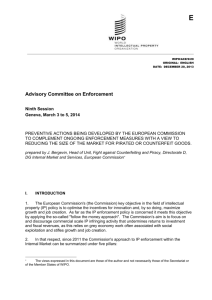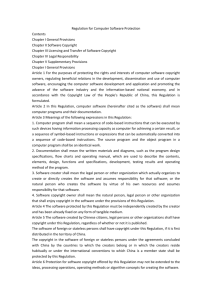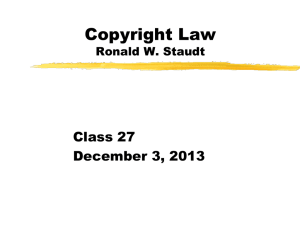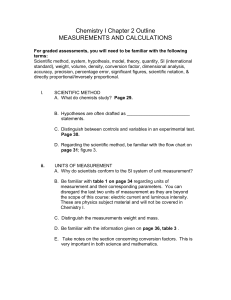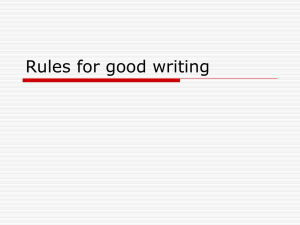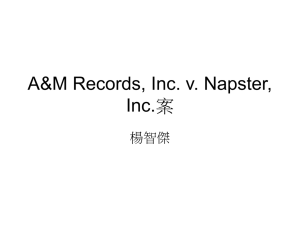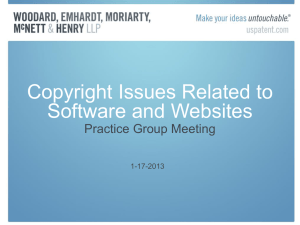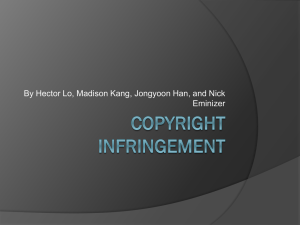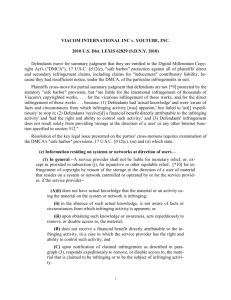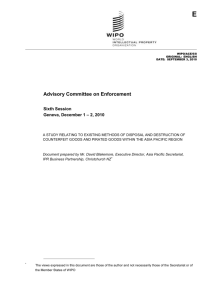Much More Than a Simple Notice and Takedown
advertisement
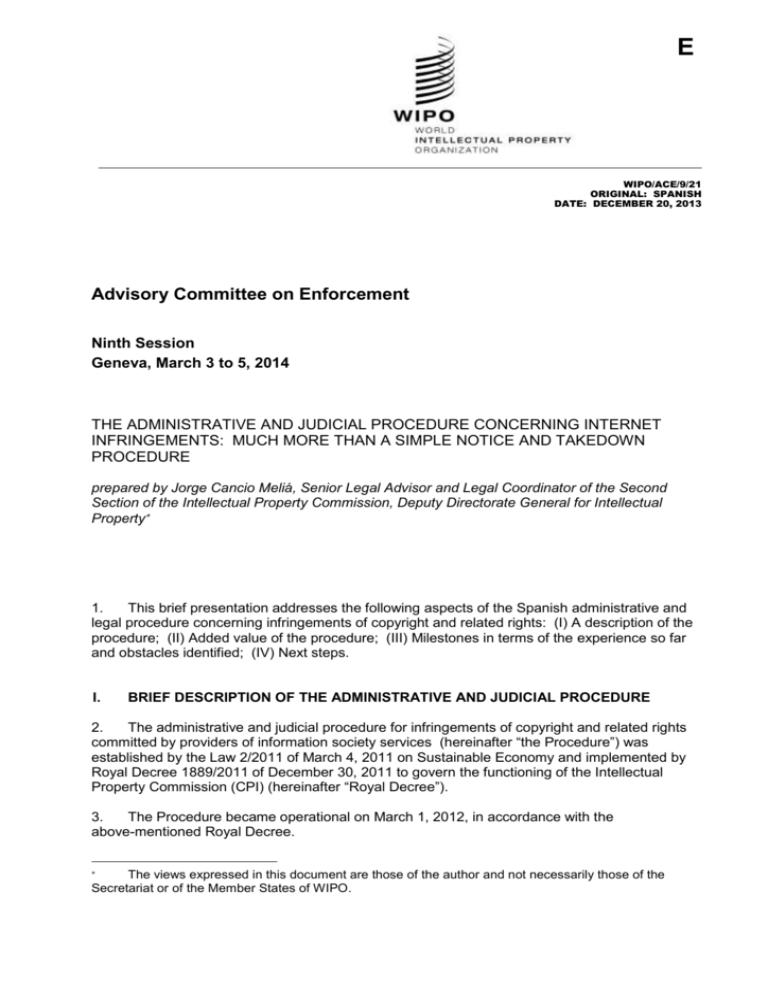
E WIPO/ACE/9/21 ORIGINAL: SPANISH DATE: DECEMBER 20, 2013 Advisory Committee on Enforcement Ninth Session Geneva, March 3 to 5, 2014 THE ADMINISTRATIVE AND JUDICIAL PROCEDURE CONCERNING INTERNET INFRINGEMENTS: MUCH MORE THAN A SIMPLE NOTICE AND TAKEDOWN PROCEDURE prepared by Jorge Cancio Meliá, Senior Legal Advisor and Legal Coordinator of the Second Section of the Intellectual Property Commission, Deputy Directorate General for Intellectual Property 1. This brief presentation addresses the following aspects of the Spanish administrative and legal procedure concerning infringements of copyright and related rights: (I) A description of the procedure; (II) Added value of the procedure; (III) Milestones in terms of the experience so far and obstacles identified; (IV) Next steps. I. BRIEF DESCRIPTION OF THE ADMINISTRATIVE AND JUDICIAL PROCEDURE 2. The administrative and judicial procedure for infringements of copyright and related rights committed by providers of information society services (hereinafter “the Procedure”) was established by the Law 2/2011 of March 4, 2011 on Sustainable Economy and implemented by Royal Decree 1889/2011 of December 30, 2011 to govern the functioning of the Intellectual Property Commission (CPI) (hereinafter “Royal Decree”). 3. The Procedure became operational on March 1, 2012, in accordance with the above-mentioned Royal Decree. The views expressed in this document are those of the author and not necessarily those of the Secretariat or of the Member States of WIPO. WIPO/ACE/9/21 page 2 OBJECT, SUBJECTS AND BASIC ELEMENTS OF THE PROCEDURE 4. Object. The object of the Procedure is any infringement of copyright and related rights committed through an information society service. “Intellectual property rights” encompass copyright and the neighboring or related rights set forth in the Spanish Consolidated Text of the Law on Intellectual Property (“TRLPI”). 5. Purpose of the Procedure. The purpose of the Procedure is to re-establish a situation of legality, that is to say, the simple termination of the infringing behavior. In order to achieve this aim, as will be shown, priority is given to the voluntary removal of the illegally-offered content or the disabling of access to said content by the party responsible for the infringement. In the absence of such cooperation, provision has been made for the adoption of measures involving the suspension of intermediary services in order to stop the infringement, at least in the Spanish territory. 6. Active subject. Any owner of copyright and related rights that have been deemed to have been infringed, or his/her representatives, including collective management bodies. 7. Passive subject. The passive subject of the Procedure is the provider of the information society service through which the infringement is committed. The definition of “information society service” stems from European Directive 1998/34/EC as amended by the European Directive 1998/48/EC and requires, among other things, that the service provider be carrying out an “economic activity” through the service, not including services provided by amateurs (such as personal blogs). The Procedure does not cover behavior such as file sharing on peerto-peer (P2P) networks by ordinary users. The behavior in question must be carried out for direct or indirect profit or must cause or be likely to cause financial damage. 8. Other interested parties. The providers of intermediary Internet services shall be notified as interested parties. Should the infringer fail to remove the infringing contents or service voluntarily, such providers shall, where relevant, cooperate with CPI. These intermediaries are governed by Law 34/2002 and are the following: Internet access and transmission services; caching services; storage services; linking or search engine services. 9. Competent body. The Procedure is carried out by the Second Section of the CPI, a body attached to the Deputy Directorate General for Intellectual Property (Ministry of Education, Culture and Sport), the members of which are high-level officials appointed by various ministerial departments, including the Ministry of Education, Culture and Sport – the competent body in terms of copyright and related rights – and the Ministry of Industry, Energy and Tourism – the competent body in terms of telecommunications. The Secretary of State for Culture presides over the Second Section. SUMMARY OF THE PROCEDURE 10. Only the owners of rights or their representatives may apply for the Procedure to be initiated. This application or request must meet a series of requirements set forth in the Royal Decree which, to a certain extent, resemble those required under notice and takedown systems for infringing content established in other countries, such as the United States Digital Millennium Copyright Act. 11. However, formal initiation of the Procedure is decided upon ex officio and is preceded by a phase involving prior checks aimed at verifying the existence of the infringement reported and identifying the infringing passive subject(s), as well as the owners of the relevant intermediary services in each case. The identification checks include the carrying out of numerous activities and the issuing of multiple requests for information, addressed to, among others, storage, advertising and privacy protection services, registrars, etc. with which the provider which is the WIPO/ACE/9/21 page 3 subject of the identification check has maintained or maintains service relationships. It should be pointed out that these requests must be made with judicial authorization when requesting an information society services provider to cooperate in the identification of an alleged infringer of rights. 12. Once the phase involving prior checks has been completed, a Report of Preliminary Proceedings is drawn up describing the checks carried out in compliance with the requirements set forth in the regulations on administrative procedures, thus enabling said document to serve as prima facie evidence. 13. Should the checks prove to be negative, that is to say, if no infringement has been verified, an agreement to discontinue the proceedings is adopted owing to the object of the Procedure ceasing to exist. 14. Should the checks prove to be positive, that is to say, the existence of an infringement is verified, an Initial Decision, i.e., an agreement to formally open the Procedure, is issued by the Second Section of the CPI, this document being an administrative decision that contains the following elements: (a) identification of the manager(s) of the infringing information society services; (b) reference to the content deemed to have been infringed by said service and reference to the location at which that content is made available; and (c) the request to the manager of the service deemed to be the infringer to remove the corresponding content within a period of 48 hours or to provide the arguments he/she deems appropriate, such as the existence of authorization, an applicable legal limit or any other circumstance in his/her defense. 15. All parties to, and stakeholders in, the Procedure are notified of the agreement to initiate and, once the 48-hour period has expired, checks are carried out to verify whether the content has been removed or not, the results of those checks being recorded in an additional proceedings report. 16. Should it be found that the content has been removed, the Second Section then discontinues the Procedure without any further steps, although in the corresponding ruling to discontinue the Procedure any of the statements which may have been made by the parties during the procedure are duly considered and answered. 17. Should it be found that the content has not been removed, the Second Section then drafts a final ruling proposal, in which it must consider and respond to each and every one of the allegations of the parties, propose a corresponding decision, and make provision for cooperation measures concerning the intermediary services which could become compulsory should the infringer fail to comply with the ruling. 18. The parties are then notified of the proposal in order to allow them to make final arguments, referred to as “closing submissions” in the Royal Decree, within a period of five days. 19. In light of said closing submissions, the Second Section issues a final ruling in which it makes a definitive determination on the case, ordering, where applicable, the removal of the content found to be infringing and setting forth the appropriate cooperation measures. 20. In accordance with the Royal Decree, the provider of the infringing information society service has 24 hours to remove the content. Once that period has expired, the CPI checks whether the content has been removed and accordingly prepares a final report on proceedings. Should the CPI find that the content has been removed, the report is added to the case file, which is archived, the parties being so informed. WIPO/ACE/9/21 page 4 21. Should it be found that the content has not been removed, judicial authorization shall be sought for the cooperation measures for which the CPI made provision for in its ruling, including, as the case may be, disconnection of the storage service provided to the infringing web site; blocking of the infringing web site by the Internet access operators established in Spain; the deactivation of the links to the infringing content or the removal from the index, by search engine services, of the URLs hosting the infringing content. 22. Should the judge authorize the measure, the parties are duly notified, the corresponding intermediary services being obliged to comply with the suspension order within a maximum of 72 hours. The maximum duration of this suspension is one year, without prejudice to a lifting of such suspension should the CPI determine that the manager of the infringing service has put an end to his/her infringing behavior. II. ADDED VALUE OF THE PROCEDURE 23. As is often pointed out, we do not (to date) have a “silver bullet” capable, on its own, of resolving the problems generated by Internet-based activities that infringe copyright and related rights 24. In fact, many agree that “anti-piracy” activities must be based on three fundamental pillars: education and awareness-raising; the promotion of legal offers adapted to new user needs and demands; copyright and related rights protection measures, including both public intervention and measures based on self-regulation. 25. This is not the time to talk about the first two pillars; I will therefore focus briefly on the third pillar: protection measures. Said measures in turn cover a wide spectrum of actions, ranging from preliminary self-protection actions (cease and desist letters), to civil and criminal legal actions, and including private notice and takedown systems and other systems of selfregulation (“Follow the Money”) in the spheres of advertising and means of payment. 26. Within this range of measures, the Procedure set forth in Law 2/2011 does not attempt to replace the other channels, but rather to provide additional added value. In this regard, Spanish legislation expressly provides that actions under this Procedure shall neither prejudice the adoption of civil or criminal actions nor, it goes without saying, the use of existing notice and takedown mechanisms by the owners of rights. 27. At a glance, the Procedure might seem to be a simple notice and takedown system, with one distinctive feature in the form of the public intervention element. 28. However, the Procedure provides added value that goes far beyond those offered by such notice and takedown systems. 29. The Procedure provides the following elements in terms of added value: The identification of infringers and other third parties involved in the Procedure. It should be remembered that the Internet anonymity of the owners of infringing web sites is one of their best means of “protection” against legal reprisals. Thus, the reliable identification of such persons constitutes a major step forward in terms of holding them responsible for their illegal acts and often leads to the voluntarily shutting down of the web sites they had been running. The intervention of a competent public authority that weighs all the arguments and allegations made by the parties, within the framework of an adversarial procedure which fully respects the principles of due process. WIPO/ACE/9/21 page 5 The determination, where relevant, by a competent public authority of the existence of an infringement of intellectual property rights, through a detailed, reasoned and justified ruling. Furthermore, the order to take down the content or to disable access includes an obligation to abstain from making the same content available in the future. The immediate adoption of interruption or suspension measures by intermediary services should the infringer fail to remove the content once the case has been definitively resolved. The generation of effective knowledge among third-party intermediary services of infringing behavior on the part of their clients, meaning that said services have a duty of diligence concerning the permanent de-activation of access to infringing content in case where said content is not removed voluntarily. 30. Thus, the Procedure should not be viewed in isolation, but rather as an additional element in the tool-box available to owners of rights who must, in each case, opt for the most successful and efficient combination of measures. III. MILESTONES IN TERMS OF THE EXPERIENCE SO FAR AND OBSTACLES IDENTIFIED 31. Since the entry into force of the Procedure on March 1, 2012, around 400 requests for initiation have been submitted to the CPI, with prior checks being carried out in each case [data provided as current in December 2013]. 32. More than 80 per cent of those 400 requests were duly processed and finalized (around 335), with the remaining 20% in course of preliminary checks. Around 50 per cent of the requests were discontinued for various reasons: either because they were deliberately flawed in nature and had been submitted as part of an attempt to hinder the Commission’s work or, for a number of other reasons. For example, some requests were actually attempts to use the Procedure for purposes other than those for which it was established (identification of P2P users) or were submitted concerning instances of use of protected works clearly covered by the law (application of limitations). 33. The rest of the cases were either discontinued owing to the infringement subsequently ceasing to exist (more than 20), or formally initiated (close to 60) where all (100 per cent) resulted in the voluntary removal of the content (involving over 90 web sites, around 18 of which were shut down completely) without the need for the Internet intermediary services to implement suspension measures. 34. Most of the decisions arising from formal procedures have taken the form of rulings to discontinue owing to voluntary removal following the first request for removal issued by the Commission. A dozen cases have been finalized through definitive rulings. 35. These formally initiated procedures have provided the Commission with the opportunity to establish various substantive criteria: WIPO/ACE/9/21 page 6 the Commission has applied to the field of copyright, the doctrine established by the Spanish Supreme Court as regards services initially deemed to be intermediary services (linking web sites) having “effective knowledge” of the existence of infringements1; the Commission has applied the doctrine developed by the Court of Justice of the European Union concerning the distinction between passive, neutral and technical intermediary services and services responsible for the content because they play an active role of such a kind as to give them knowledge of, or control over, the infringing content2; the Commission has deemed that, in certain circumstances, managers of linking web sites offering deep-links or P2P links who systematically, actively and knowingly localize illegally-offered content, infringe the relevant exclusive economic and public communication rights and should therefore be viewed as infringers, rather than mere intermediaries or third parties. 36. The main obstacles identified are listed below: the lack of policies concerning the accuracy of registration data for generic Internet domain names (such as “.com”), making it extremely difficult to identify the owners of such domain names, in particular when storage, advertising and payment services located abroad are used. In direct contrast to this situation, the framework applied to “.es” guarantees the accurate identification of domain name owners, failure of which may result in the cancellation of the domain name through a rapid and adversarial procedure; the massive use of privacy protection or identification data masking services concerning generic Internet domains; the limitation of collaborative measures aimed at technical Internet intermediary services, with no provision being made for online payment or advertising services; the Procedure being focused overly on individual works, which does not currently allow to establish sampling systems relating to works or subject matter infringed in circumstances similar to those prevailing in the cases investigated; the lack of prior requirements concerning requests for the initiation of the Procedure that would require a minimum of effort in terms of self-protection on the part of the owners affected; or a minimum level of relevance of the infringement detected in terms of the number of works, subject matter, or visitors to the infringing web site. IV. NEXT STEPS 37. Aware of the difficulties identified, the Spanish Government is taking action on two main fronts: 1 Amongst others in the Ruling of the Civil Chamber of the Supreme Court number 72/2011, adopted on February 10, 2011. 2 See amongst others the Judgment of the Court (Grand Chamber) of 12 July 2011, L’Oréal SA and Others v eBay International AG and Others, docket C-324/09. WIPO/ACE/9/21 page 7 the promotion, through bilateral action and action within the Internet Corporation for Assigned Names and Numbers (ICANN), of a more balanced framework concerning the identification of the owners of generic domain names exercising an economic activity; the promotion of reforms concerning the regulatory framework currently in force: (a) promoting a project to amend the Law on copyright and related rights, which will involve the introduction of the following improvements: clarification that sophisticated linked web sites are involved in the economic exploitation of works localized by them whenever those sites display certain characteristics; the empowerment of the CPI to broaden the range of works or subject matters to be protected in each case file; the establishment of minimum requirements concerning the prior reporting of infringements and prior efforts in terms of self-protection; the broadening of the scope of the range of cooperation measures to cover advertising and electronic payment service providers – at the same time promoting self-regulatory solutions in said spheres; the establishment of administrative sanctions for repeat infringers; the promotion of self-regulation for technical intermediaries in the spheres of payment and advertising; the improvement of civil procedural measures concerning the identification of large-scale infringers. (b) promoting reforms of the Criminal Code that will close the gap represented by the lack of criminal prosecution of behavior involving the sophisticated localization on the Internet of infringing content for profit and to the detriment of third parties. [End of document]
